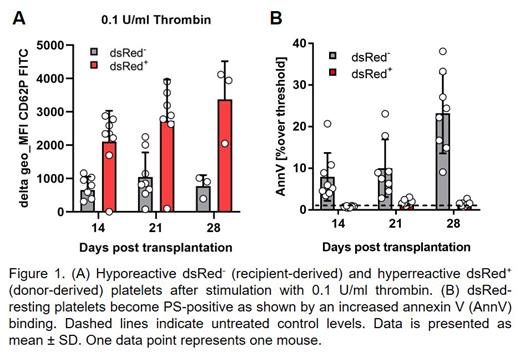Allogeneic hematopoietic stem cell transplantation (HSCT) is often accompanied by bleeding complications due to delayed platelet engraftment. Despite having prolonged thrombocytopenia, patients can also develop thrombotic events. The mechanisms leading to HSCT-related hemorrhage and thrombosis, and especially platelet activity in these patients are yet unknown. Our study aimed to decipher post HSCT megakaryocyte (MK) engraftment and platelet function in a murine model of bone marrow transplantation (BMT) and in patients undergoing HSCT.
C57BL/6 mice were lethally irradiated with 10 Gy total body irradiation prior to BMT. Radiation exposure led to massive BM remodeling, including extracellular matrix degradation, vasodilation and aberrant pericyte morphology, accompanied by extensive ectopic platelet release into the BM cavity, which might contribute to thrombocytopenia. We used Actb dsRed reporter mice as BM donors allowing us to track all donor-derived (dsRed +) cells after BMT. Femurs were removed after 14 days and subjected to confocal laser immunofluorescence microscopy using lineage-specific markers. While we found an overall homogenous engraftment pattern for red blood cells and most leukocyte sub-lineages, the engraftment pattern for MKs and Ly6G + cells was characterized by long triangular clusters at the bone cortex. We manipulated BM engraftment by transplanting different numbers of graft cells. Within 2 weeks after BMT with 6 x 10 6 BM cells per mouse, a complete chimerism was achieved for both MKs in BM and platelets in peripheral blood. These newly formed platelets had an increased platelet size, while the surface expression levels (CD41/CD42/GPVI) were decreased by half, implying a massive reduction in receptor density. Flow cytometry analyses of agonist-stimulated platelets revealed a severely impaired granule release and integrin activation that was confirmed by aggregometry. When only 1 x 10 6 BM cells per mouse were transplanted, we found an extended mixed MK chimerism after BMT. During the first 28 days, we detected both dsRed - (recipient-derived) and dsRed + (donor-derived) MKs in the recipient BM and, concomitantly, dsRed - and dsRed + platelets in peripheral blood. Unexpectedly, we observed opposing agonist-induced platelet reactivity with hyporeactive dsRed - platelets, while dsRed + platelets were hyperreactive, indicating that 2 BM MK subpopulations generate 2 functionally distinct platelet subpopulations. Intriguingly, we found an upregulation of annexin V binding on dsRed -, but not on dsRed + resting platelets, implying that the myeloablative conditions preceding HSCT result in increased phosphatidylserine (PS) exposure, a key sign of pro-coagulant platelets. In vitro thrombus formation was assessed under flow using a whole blood collagen-coated microfluidic device. While surface coverage was mildly increased, thrombus volume remained comparable to controls. dsRed + platelets exhibited a distinct incorporation pattern by preferentially attaching to the edges of growing thrombi, indicating that dsRed - and dsRed + platelets may differ in thrombus initiation and growth.
While platelet count and other blood cell parameters are routinely monitored in HSCT patients, the functional capacity of graft-derived platelets has not yet been systematically assessed. We thus performed extended platelet function analyses in 13 adult patients (aged 24-73 years) undergoing allogeneic HSCT for malignant leukemic diseases (mostly acute myeloid leukemia) and detected a massive platelet hyporeactivity for up to 100 days observation time after HSCT. Integrin activation was severely impaired upon stimulation of PAR-1 or GPVI. In contrast to mice, α granule release, monitored by P-selectin neo-exposure, was only slightly reduced compared to healthy controls, suggesting a decoupling of integrin activation and P-selectin exposure. In line with our findings in mice, we detected a pronounced upregulation in the proportion of pro-coagulant PS-positive platelets with a reduced mitochondrial membrane potential.
Our data demonstrate that a mixed chimerism after HSCT results in two co-existing platelet subpopulations with opposing response profiles. This unexpected finding provides the first experimental evidence why bleedings and thromboembolic events can both occur after HSCT and hints toward pro-coagulant platelets as a potential therapeutic target.
Disclosures
Kraus:BMS: Honoraria, Other: Support for meeting attendance; Jazz Pharmaceuticals: Honoraria, Other: Support for meeting attendance; Gilead: Other: Support for meeting attendance; LinkCare: Honoraria; AstraZeneca: Speakers Bureau; Janssen: Honoraria; Pfizer: Honoraria.


This feature is available to Subscribers Only
Sign In or Create an Account Close Modal